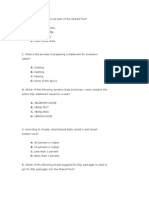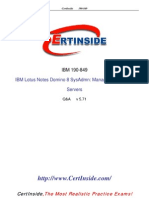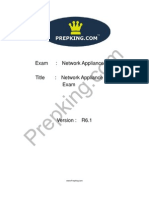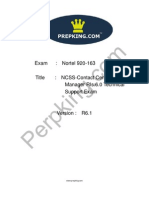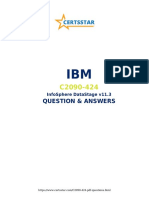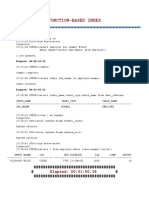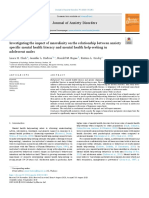0 ratings0% found this document useful (0 votes)
99 viewsOracle
SMON process performs instance recovery by rolling forward and applying changes in the redo log to synchronize data files. During a checkpoint, Oracle flushes dirty blocks from the database buffer cache to disk. SMON does not write to the online redo log files. A transaction is not considered committed until the log writer (LGWR) successfully writes the changes to the redo log.
Uploaded by
methukupallyCopyright
© © All Rights Reserved
Available Formats
Download as DOC, PDF, TXT or read online on Scribd
0 ratings0% found this document useful (0 votes)
99 viewsOracle
SMON process performs instance recovery by rolling forward and applying changes in the redo log to synchronize data files. During a checkpoint, Oracle flushes dirty blocks from the database buffer cache to disk. SMON does not write to the online redo log files. A transaction is not considered committed until the log writer (LGWR) successfully writes the changes to the redo log.
Uploaded by
methukupallyCopyright
© © All Rights Reserved
Available Formats
Download as DOC, PDF, TXT or read online on Scribd
You are on page 1/ 2
Architecture 2
Architecture 2
1. What is the function of SMON in instance recovery?
A.It writes data to the archive log files.
B.It writes data to the online redo log files.
C.It frees resources held by user processes.
D.It synchronizes data file header and control files.
E.It roles forward by applying changes in the redo log.
F.It writes dirty buffers from the buffer cache to the data files.
Correct answer: e
2. Which action occur during a checkpoint?
A.Oracle updates the parameter file.
B.Oracle performs a delayed block clean-out.
C.Oracle copies the online redo-log to the archive destinations.
D.Oracle flushes the dirty blocks in the database buffer cache to disk.
Correct answer: d
3. SMON process is used to write into LOG files
a.TRUE
b.FALSE
Correct answer: b
4. Oracle does not consider a transaction committed until
A. The Data is written back to the disk by DBWR
B. The LGWR successfully writes the changes to redo
C. PMON Process commits the process changes
D. SMON Process Writes the data
Correct answer: b
5. How many maximum DBWn(Db writers) we can invoke?
A. 36
B. 1
C. 10
D. 20
Correct answer: a
6. Which activity would generate less undo data?
A.INSERT
B.UPDATE
C.SELECT
D.DELETE
Correct answer: a
www.wilshiresoft.com Wilshire Software Technologies Rev. Dt : Aug 2013
Hyderabad, Telephone No. 040 – 23757906 / 07
Architecture 2
7. What happens when a user issues a COMMIT?
A. The CKPT process signals a checkpoint.
B. The DBWn process wrtes the transactions changed buffers to the datafiles.
C. The LGWR flushes the log buffer to the online redo log.
D. The ARCn process writes the change vectors to the archive redo log
Correct answer: c
8.What happens when a user process fails?
A.PMON performs process recovery.
B.SMON performs ICR
C.SMON frees resources held by user process.
D.Oracle Updates a controlfile.
Answer:a
9. What are the free buffers in the database buffer cache.
A.Buffer that have changed should be pushed to the disk.
B.Buffers that are currently in use.
C.Buffer that are being written to disk.
D.Buffer that can be overwritten.
Answer:d
10. When the SMON Procees perform ICR.
A.For every startup
B.Only at the time of startup after graceful shutdown
C.Only at the time of startup after abort shutdown
Answer:c
www.wilshiresoft.com Wilshire Software Technologies Rev. Dt : Aug 2013
Hyderabad, Telephone No. 040 – 23757906 / 07
You might also like
- 1Z0-497 - Dumps: 1. Which Statement About CDB Architecture Is True?No ratings yet1Z0-497 - Dumps: 1. Which Statement About CDB Architecture Is True?36 pages
- VCS-277.exam: Number: VCS-277 Passing Score: 800 Time Limit: 120 Min File Version: 1.0No ratings yetVCS-277.exam: Number: VCS-277 Passing Score: 800 Time Limit: 120 Min File Version: 1.025 pages
- 1Z0-062 Exam Dumps With PDF and VCE Download (1-30)No ratings yet1Z0-062 Exam Dumps With PDF and VCE Download (1-30)6 pages
- 1. DBA-MCQ (MCQ-88)-from-Muhammad Nur E Alam-for DBA-for-StudentsNo ratings yet1. DBA-MCQ (MCQ-88)-from-Muhammad Nur E Alam-for DBA-for-Students11 pages
- Dumpsfree: Dumpsfree Provide High-Quality Dumps Vce & Dumps DemoNo ratings yetDumpsfree: Dumpsfree Provide High-Quality Dumps Vce & Dumps Demo5 pages
- IBM EXAM 000-539 IBM Tivoli Storage Manager V6.2 AdministrationNo ratings yetIBM EXAM 000-539 IBM Tivoli Storage Manager V6.2 Administration45 pages
- VCS-279.examcollection - Premium.exam.89q HLNTGXN PDFNo ratings yetVCS-279.examcollection - Premium.exam.89q HLNTGXN PDF31 pages
- 1Z0 062 Oracle Database 12cinstallation and Administration PDFNo ratings yet1Z0 062 Oracle Database 12cinstallation and Administration PDF146 pages
- Exam: 000-021:: IBM Tivoli Workload Scheduler V8.5 LmplementationNo ratings yetExam: 000-021:: IBM Tivoli Workload Scheduler V8.5 Lmplementation6 pages
- (Feb-2017) New 1Z0-062 Exam Dumps With PDF and VCE DownloadNo ratings yet(Feb-2017) New 1Z0-062 Exam Dumps With PDF and VCE Download7 pages
- Testkings_1z0_062_108q_Oracle_1z0_062_OrNo ratings yetTestkings_1z0_062_108q_Oracle_1z0_062_Or95 pages
- 1Z0-050 Oracle Database 11g - New Features For AdministratorsNo ratings yet1Z0-050 Oracle Database 11g - New Features For Administrators10 pages
- DBA Certified Exam Answer All Questions and Submit The Answers To My Email Before Tuesday 08 /03/2012 3:00 PMNo ratings yetDBA Certified Exam Answer All Questions and Submit The Answers To My Email Before Tuesday 08 /03/2012 3:00 PM14 pages
- oracle.passleader.1z0-083.exam.prep.2021-oct-31.by.cecil.127q.vceNo ratings yetoracle.passleader.1z0-083.exam.prep.2021-oct-31.by.cecil.127q.vce8 pages
- Question & Answers: Infosphere Datastage V11.3No ratings yetQuestion & Answers: Infosphere Datastage V11.34 pages
- Oracle: Oracle Database 11g: Administration IINo ratings yetOracle: Oracle Database 11g: Administration II8 pages
- Oracle Passit4sure 1z0-062 v2017-09-14 by Johan 183qNo ratings yetOracle Passit4sure 1z0-062 v2017-09-14 by Johan 183q145 pages
- I Did Not Give or Receive Any Unauthorized Help in Doing This Exam. The Exam Is My Own WorkNo ratings yetI Did Not Give or Receive Any Unauthorized Help in Doing This Exam. The Exam Is My Own Work10 pages
- DEA-1TT4.prepaway - Premium.exam.114q: Number: DEA-1TT4 Passing Score: 800 Time Limit: 120 Min File Version: 2.067% (3)DEA-1TT4.prepaway - Premium.exam.114q: Number: DEA-1TT4 Passing Score: 800 Time Limit: 120 Min File Version: 2.042 pages
- Question & Answers: Infosphere Datastage V11.3No ratings yetQuestion & Answers: Infosphere Datastage V11.34 pages
- VCS-279.examsforall - Premium.exam.89q: Number: VCS-279 Passing Score: 800 Time Limit: 120 Min File Version: 1.0No ratings yetVCS-279.examsforall - Premium.exam.89q: Number: VCS-279 Passing Score: 800 Time Limit: 120 Min File Version: 1.045 pages
- oracle.certforall.1z0-083.pdf.exam.2020-oct-06.by.felix.54q.vceNo ratings yetoracle.certforall.1z0-083.pdf.exam.2020-oct-06.by.felix.54q.vce9 pages
- Question & Answers: Infosphere Datastage V11.3No ratings yetQuestion & Answers: Infosphere Datastage V11.34 pages
- Kubernetes and Cloud Native Associate (KCNA) Exam PreparationFrom EverandKubernetes and Cloud Native Associate (KCNA) Exam PreparationNo ratings yet
- Exam AZ-800: Administering Windows Server Hybrid Core Infrastructure PreparationFrom EverandExam AZ-800: Administering Windows Server Hybrid Core Infrastructure PreparationNo ratings yet
- Kids Christmas Party: Hosted by Social Service PeopleNo ratings yetKids Christmas Party: Hosted by Social Service People1 page
- G.K. (Assignment) : Q.1. Multiple Choice QuestionsNo ratings yetG.K. (Assignment) : Q.1. Multiple Choice Questions2 pages
- Difference Between Non-Indexed and Indexed Table: Elapsed: 00:11:33.29No ratings yetDifference Between Non-Indexed and Indexed Table: Elapsed: 00:11:33.294 pages
- Linux Admin Reference - NTP Configuration and Troubleshooting PDFNo ratings yetLinux Admin Reference - NTP Configuration and Troubleshooting PDF7 pages
- 2018-11-22-Job Description Senior Linux AdminNo ratings yet2018-11-22-Job Description Senior Linux Admin1 page
- 1best Practices For Migrating SAP Systems To Ora... - Oracle CommunityNo ratings yet1best Practices For Migrating SAP Systems To Ora... - Oracle Community4 pages
- Installing & Configuring Linux Webmin - Linux Web-Based AdministrationNo ratings yetInstalling & Configuring Linux Webmin - Linux Web-Based Administration27 pages
- Misplaced / Lost - Dividend / Redemption WarrantsNo ratings yetMisplaced / Lost - Dividend / Redemption Warrants1 page
- The Rotordynamics Analysis of The Washing Machine Shaft Supported by Passive MagneticNo ratings yetThe Rotordynamics Analysis of The Washing Machine Shaft Supported by Passive Magnetic22 pages
- Research Article: Modelling of Dual-Junction Solar Cells Including Tunnel JunctionNo ratings yetResearch Article: Modelling of Dual-Junction Solar Cells Including Tunnel Junction6 pages
- Blavatsky's Diagram of Meditation and The Process of Spiritual TransformationNo ratings yetBlavatsky's Diagram of Meditation and The Process of Spiritual Transformation7 pages
- Metal Forming Lecture 3 Stress Strain AnalysesNo ratings yetMetal Forming Lecture 3 Stress Strain Analyses30 pages
- Specification FOR Saw, Plaster, Hand: Re Sffirrmd 191100% (1)Specification FOR Saw, Plaster, Hand: Re Sffirrmd 1912 pages
- Instant download The Mind As a Scientific Object Between Brain and Culture 1st Edition Christina E. Erneling pdf all chapterNo ratings yetInstant download The Mind As a Scientific Object Between Brain and Culture 1st Edition Christina E. Erneling pdf all chapter55 pages
- How To Add, Subtract, Multiply, Divide in ExcelNo ratings yetHow To Add, Subtract, Multiply, Divide in Excel6 pages
- A0056006120-Audi A6 Suspension Service Manual - Running Gear Front-Wheel Drive and Four-Wheel Drive100% (1)A0056006120-Audi A6 Suspension Service Manual - Running Gear Front-Wheel Drive and Four-Wheel Drive468 pages
- Waste Water Treatment 2023 Mid Sem Question PaperNo ratings yetWaste Water Treatment 2023 Mid Sem Question Paper4 pages
- Acoustical Board Product Data Sheet: DescriptionNo ratings yetAcoustical Board Product Data Sheet: Description2 pages
- Julia & Ijulia Cheat-Sheet (For 18.Xxx at Mit, Julia 1.X) : Basics: Arithmetic and Functions of NumbersNo ratings yetJulia & Ijulia Cheat-Sheet (For 18.Xxx at Mit, Julia 1.X) : Basics: Arithmetic and Functions of Numbers1 page
- Discombobulator Mini-Tutorial (Evan's Plugins)100% (1)Discombobulator Mini-Tutorial (Evan's Plugins)3 pages
- Penjelasan Project SIK - 2022-2023 GasalNo ratings yetPenjelasan Project SIK - 2022-2023 Gasal5 pages
- Journal of Anxiety Disorders: Laura H. Clark, Jennifer L. Hudson, Ronald M. Rapee, Katrina L. GrasbyNo ratings yetJournal of Anxiety Disorders: Laura H. Clark, Jennifer L. Hudson, Ronald M. Rapee, Katrina L. Grasby8 pages


















